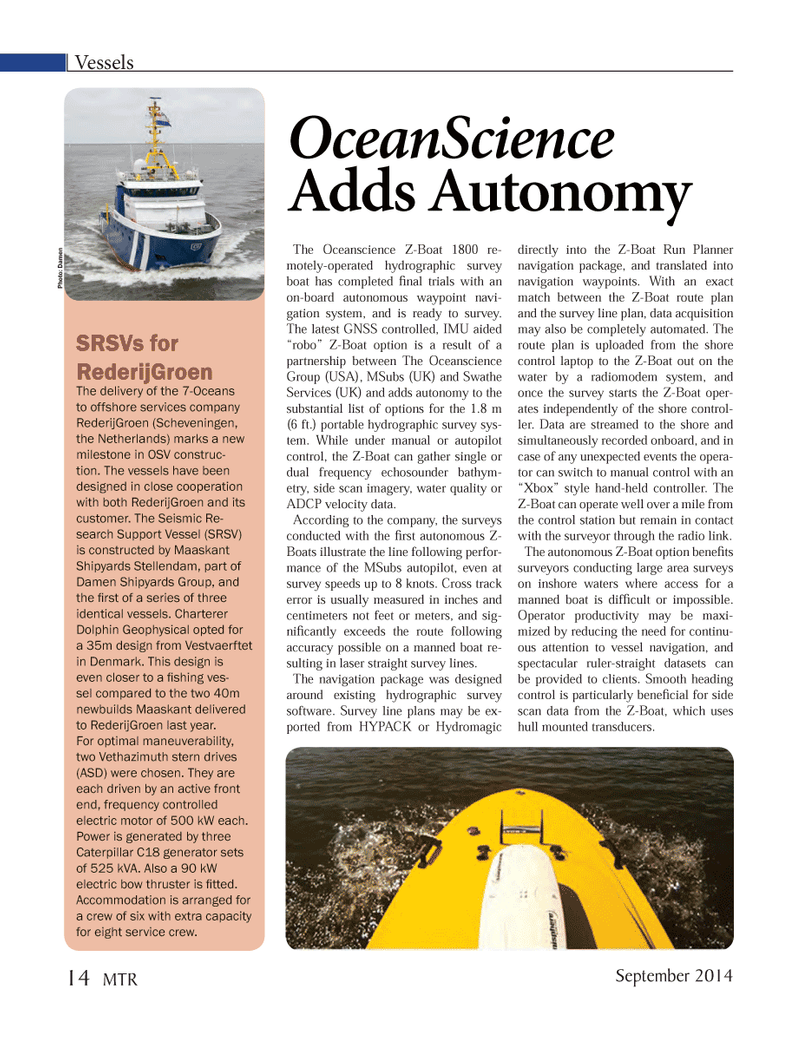
Page 14: of Marine Technology Magazine (September 2014)
Ocean Observation: Gliders, Buoys & Sub-Surface Networks
Read this page in Pdf, Flash or Html5 edition of September 2014 Marine Technology Magazine
The Oceanscience Z-Boat 1800 re- motely-operated hydrographic survey boat has completed fi nal trials with an on-board autonomous waypoint navi- gation system, and is ready to survey.
The latest GNSS controlled, IMU aided “robo” Z-Boat option is a result of a partnership between The Oceanscience
Group (USA), MSubs (UK) and Swathe
Services (UK) and adds autonomy to the substantial list of options for the 1.8 m (6 ft.) portable hydrographic survey sys- tem. While under manual or autopilot control, the Z-Boat can gather single or dual frequency echosounder bathym- etry, side scan imagery, water quality or
ADCP velocity data.
According to the company, the surveys conducted with the fi rst autonomous Z-
Boats illustrate the line following perfor- mance of the MSubs autopilot, even at survey speeds up to 8 knots. Cross track error is usually measured in inches and centimeters not feet or meters, and sig- nifi cantly exceeds the route following accuracy possible on a manned boat re- sulting in laser straight survey lines.
The navigation package was designed around existing hydrographic survey software. Survey line plans may be ex- ported from HYPACK or Hydromagic directly into the Z-Boat Run Planner navigation package, and translated into navigation waypoints. With an exact match between the Z-Boat route plan and the survey line plan, data acquisition may also be completely automated. The route plan is uploaded from the shore control laptop to the Z-Boat out on the water by a radiomodem system, and once the survey starts the Z-Boat oper- ates independently of the shore control- ler. Data are streamed to the shore and simultaneously recorded onboard, and in case of any unexpected events the opera- tor can switch to manual control with an “Xbox” style hand-held controller. The
Z-Boat can operate well over a mile from the control station but remain in contact with the surveyor through the radio link.
The autonomous Z-Boat option benefi ts surveyors conducting large area surveys on inshore waters where access for a manned boat is diffi cult or impossible.
Operator productivity may be maxi- mized by reducing the need for continu- ous attention to vessel navigation, and spectacular ruler-straight datasets can be provided to clients. Smooth heading control is particularly benefi cial for side scan data from the Z-Boat, which uses hull mounted transducers.
Vessels
SRSVs for
RederijGroen
The delivery of the 7-Oceans to offshore services company
RederijGroen (Scheveningen, the Netherlands) marks a new milestone in OSV construc- tion. The vessels have been designed in close cooperation with both RederijGroen and its customer. The Seismic Re- search Support Vessel (SRSV) is constructed by Maaskant
Shipyards Stellendam, part of
Damen Shipyards Group, and the fi rst of a series of three identical vessels. Charterer
Dolphin Geophysical opted for a 35m design from Vestvaerftet in Denmark. This design is even closer to a fi shing ves- sel compared to the two 40m newbuilds Maaskant delivered to RederijGroen last year.
For optimal maneuverability, two Vethazimuth stern drives (ASD) were chosen. They are each driven by an active front end, frequency controlled electric motor of 500 kW each.
Power is generated by three
Caterpillar C18 generator sets of 525 kVA. Also a 90 kW electric bow thruster is fi tted.
Accommodation is arranged for a crew of six with extra capacity for eight service crew.
Photo: Damen
OceanScience
Adds Autonomy
September 2014 14 MTR
MTR #7 (1-17).indd 14 8/27/2014 11:10:13 AM

 13
13

 15
15
